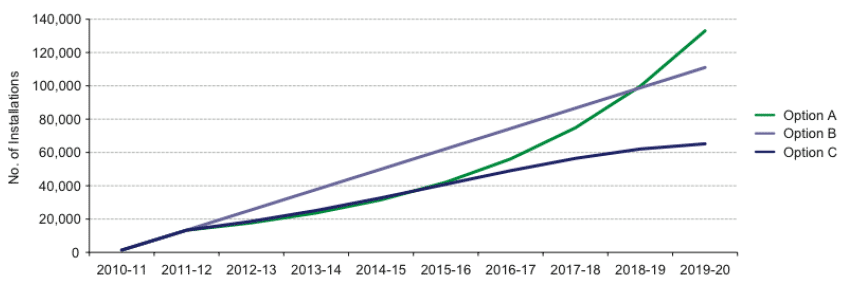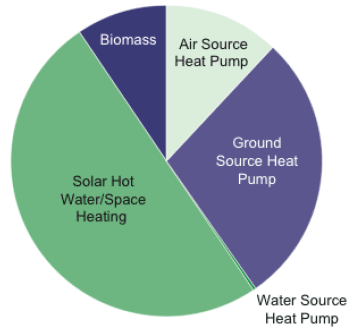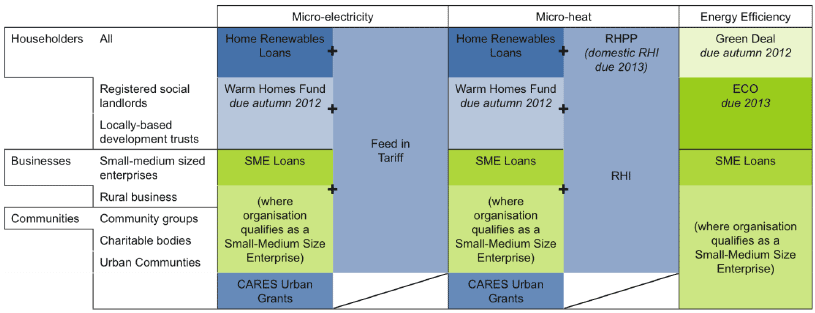Microgeneration strategy for Scotland
Following on from the Renewables Routemap 2020, this is a sectoral routemap for microgeneration.
2 Deployment
Successes and Actions To Date
- Energy Saving Trust Renewable Heat in Scotland Report estimates that in 2010, microgeneration accounted for 53 MW of capacity, generating 151,000 MWh of heat, the equivalent of the average heat use of over 10,000 Scottish homes.
- Since 2007, the Scottish Government has provided nearly £13 million in grants and loans direct to householders to help install microgeneration and continues to fund interest free loans for householders through the Home Renewables and Home Loans schemes to help them benefit from the Feed in Tariff ( FIT) and Renewable Heat Premium Payments ( RHPP).
- Over 17,000 installations registered under the FIT in Scotland with 59 MW capacity installed on houses, out of total 72 MW.
- 283 community microgeneration installations have been support by the Scottish Government's Community and Renewable Energy Scheme (CARES) managed by Community Energy Scotland.
- Community Energy Scotland advised just under 50 community organisations in deprived, urban areas on energy efficiency and renewable technologies through the Urban Development Grant Scheme and of these 24 urban projects in deprived areas were match funded from CARES of just over £300,000.
- A searchable database and map of exemplar projects is available on Community Energy Scotland's website.
- The Scottish Government funds Small Business Loans for Small-Medium Sized Enterprises ( SMEs) for energy efficiency and renewable energy. A total of 143 loans worth £5.4 million have been paid to SMEs for renewable installations, and a further 39 loans worth £1,482 for combined renewables and energy efficiency measures.
- The Woodfuel Usage Study 2011 reports an increasing number of small-scale woodfuel systems, 230 in 2010, including microgeneration installations heating primary schools, village halls, offices, and small businesses.
- Scottish Government has worked with local authorities and registered social landlords to develop solar PV projects, with installation on around 800 homes in Scotland, including 500 installed by Glasgow Housing Association.
2.1 Growing the market for microgeneration
Electricity generation
The Feed in Tariff ( FIT) has driven rapid growth, with over 17,000 FIT-registered installations in Scotland (see Table 1). Solar PV is the most popular technology making up 94% of the installations and 73% of installed capacity, mainly on individual homes with an average capacity of around 3 kW. Scotland is also benefitting from its wind and hydro resources, which make up a larger proportion of installed capacity. Domestic wind turbines generally range between 4 to 15 kW and the average size of a domestic hydro scheme is 10 kW.
Businesses and communities are also taking up microgeneration. Loans from the Scottish Government's Community and Renewable Energy Schemes ( CARES), managed by Community Energy Scotland, have helped communities benefit from the FIT, with 39 community wind projects up and running and more in the pipeline. Micro-hydro schemes range from smaller domestic schemes to larger community and commercial projects. An update on the 2008 Hydro Resource Study estimates there could be 1.2 Gigawatts of potential hydro capacity across 7,043 schemes, largely micro-hydro.
Camphill workshop, Blair Drummond
Through a CARES grant, Camphill now have a large, light and airy workspace built specifically around the needs of the adults supported by Camphill. Camphill provides meaningful daily activities for people with learning disabilities.
Ground Source Heat Pumps have made a huge contribution to the success of the newly named Eastwood workshop. They ensure the workshop remains at a comfortable temperature for working all the year 'round. The charity also prides itself in minimising their impact on the environment and always source organic and 'green' options where possible, the GSHPs have fitted perfectly with this ethos.
More information on community projects is available on the online database and map of exemplar projects on the Community Energy Scotland website.
Table 1: Total number and capacity of installation registered in Scotland under the Feed in Tariff, including microgeneration
| Technology | Domestic Installations | Commercial Installations | Industrial Installations | Community Installations | Total Installations | |
|---|---|---|---|---|---|---|
| Hydro | 63 | 10 | 0 | 1 | 74 | 0.4% |
| Micro CHP | 21 | 0 | 0 | 0 | 21 | 0.1% |
| Photovoltaic | 15,995 | 237 | 6 | 23 | 16,261 | 93.8% |
| Wind | 782 | 154 | 9 | 39 | 984 | 5.7% |
| Total Installations | 16,861 | 401 | 15 | 63 | 17,340 | |
| Installed capacity (MW) | Installed capacity (MW) | Installed capacity (MW) | Installed capacity (MW) | Installed capacity (MW) | ||
| Hydro | 0.855 | 3.113 | 0 | 0.015 | 3.983 | 5.5% |
| Micro CHP | 0.021 | 0 | 0 | 0 | 0.021 | 0.0% |
| Photovoltaic | 50.749 | 2.274 | 0.052 | 0.156 | 52.961 | 72.9% |
| Wind | 7.878 | 6.431 | 0.173 | 1.201 | 15.684 | 21.6% |
| Total Installed Capacity (MW) | 59.23 | 11.818 | 0.225 | 1.372 | 72.649 |
(Source: Ofgem Renewables and CHP Register as at 15 June 2012)
The installation rate for solar PV peaked in the run up to the 12 December 2012 reference date proposed by the UK Government to reduce eligibility for the existing tariffs, under its consultation on the Comprehensive Review of the FIT. The UK Government have now proposed long-term tariff setting mechanisms to provide greater certainty for installers and consumers. The mechanism will lead to further reductions in order to keep the FIT scheme in line with the budget, but should provide a clearer framework within which businesses can operate.
The UK Government has also set out its proposed tariffs for non- PV technologies, in its Phase 2B consultation on the Comprehensive Review, including wind, hydro, anaerobic digestion and micro- CHP (now closed). The consultation also looks at various administration issues and examines the potential of options for community developments that would give greater certainty in respect of tariffs.
Scenarios for growth
Solar PV dominates the number of FIT-eligible installations and is likely to continue to do so. Wind and hydro will make a more significant contribution to capacity, and while there is the potential for significant growth in micro- CHP by 2020, if the technology can be commercialised in the near future, the scenarios below are based on the current deployment proportions.
Solar Cities Scotland aims to develop and promote the use of renewable energy in all its forms and offer practical advice on low carbon living for urban communities across Scotland. Their demonstration Eco House in Dundee serves as a base for their staff to operate and as source for inspiration for the public to see renewables and Eco living in action.
As the rapid changes in the last year work through the market and the future landscape becomes clearer, we have looked at a number of scenarios for continued uptake of microgeneration, in discussion with our Stakeholder group. Option A and Option C, illustrated in Figure 1, show the potential variations around a baseline of based on installations rates in 2011.
Option A shows an ambitious, but sustainable, trajectory, delivering around 130,000 installations by 2020. The growth of solar PV under a high FIT tariff demonstrates the potential for much higher market rates, but in discussions with stakeholders, we believe Option A represents a level at which the market can grow sustainably.
Option C presents a worst case scenario with a decline in uptake, assuming the growth rate experienced prior to the FIT review was unsustainable. While there is a risk that this is the case, we believe that we have seen the development of a robust sector for microgeneration, particularly solar PV, and the actions in this Strategy aim to ensure that we do not see such a decline.
Our actions, along with greater certainty over the FIT tariffs, should allow the market to rebuild confidence in the coming months and get back on track. As set out in Action 1, we will work with the Microgeneration Task Group to review the scenarios by the end of the year.
Figure 1: Uptake of microgeneration - scenarios for growth

A. Deployment projection based upon an increase of approximately 33% annually from February 2012 reported levels. Assumes the growth rate estimated post 2014/15 is observed over the whole period.
B. Deployment projection based upon the annual increase observed in 2011. This projection assumes that the total demand for microgeneration is constrained at approximately the number of installations in 2011.
C. Deployment projection based upon a Q1 2012 growth rate, declining annually by 5%. Assumes a higher than expected installation cost for microgeneration and lower than expected uptake.
2.2 Renewable heat
Since 2003, the Scottish Government through its Home Renewables Loans and previous grant scheme has paid £13 million to 5,000 householders to install renewable technology to heat their homes. Since the RHPP was introduced in August 2011, nearly 1,000 vouchers worth around £789,000 have been issued to households in Scotland, representing 14% of the total value of vouchers issued under Phase 1 of the scheme.
Figure 2 shows the breakdown of installations for heat by technology. Solar thermal and heat pumps have been the most popular technologies. Biomass has also made up a significant proportion, particularly in rural areas and we have seen major investment in manufacturing of high grade wood pellets in Scotland.
Figure 2: Scottish Government funded domestic renewable heat installations by technology

Increasing fossil fuel costs can have a big impact on businesses, particularly in rural areas. As a result farms, estates, hotels and B&Bs have benefitted from targeted grant schemes such as the Scottish Biomass Heat Scheme to switch to renewable heat. Around 143 businesses have taken advantage of our Small Business Loans Scheme, managed by EST, to install a range of renewable heat technologies.
Case Studies - Biomass for Business
Cloud House Café - pellet boiler
Culfail Hotel - log boiler
Woodfuel in Practice - the Hospitality Industry in Scotland - woodfuel installations
Since its launch in November 2011, businesses have been able to take advantage of the RHI and our Small Business Loans which can help business overcome the capital barriers. We will be taking action, as set out in Section 4, to look at how we improve awareness of the RHI to maximise the opportunities for businesses to invest in renewable heat, to deliver both cost savings and reduce their carbon footprint
Affordable Warmth
Our ambition to see more homes heated with renewable energy is strongly linked to our objectives to improve Scotland's housing stock. We will consult on a Sustainable Housing Strategy which will set out our vision for warm, high quality, affordable, low carbon homes and a housing sector that helps to establish a successful low carbon economy across Scotland. This includes plans for a National Retrofit programme which will feature area-based schemes focused on tackling fuel poverty with a leading role for local councils, using Scottish Government funding to bring together a range of funding streams and lever maximum investment by the energy companies into Scotland.
Scenarios for growth
To support these objectives, the Low Carbon Scotland report set a target of 100,000 homes to have some form of renewable heat by 2020. To achieve this milestone, there needs to be a significant increase in the uptake of renewable heat technologies by individual households, matched by a growth in the number of households on district heating. If microgeneration is to deliver half of this milestone - 50,000 installations - by 2020, the uptake in renewable heat technologies would need to increase to at least 5,000 per year. The development of the domestic market will create economies of scale which will benefit business and community installations.
2.3 Growing demand
Scottish Government Support for Microgeneration
A key action in the Scottish Government's Sectoral Routemap for Microgeneration is to maximise the uptake of the RHPP, RHI and FIT in Scotland. The Scottish Government provides financial support to assist householders install renewables through its Home Renewables Loans Scheme, for communities through the Community and Renewable Energy Scheme ( CARES) and for small businesses through its Small Business Loans.
The Warm Homes Fund (£50m over five years) will support communities in areas with high levels of fuel poverty, to help them to set up projects providing lower-cost energy generated from renewable sources, reducing fuel bills for individual households, and/or creating new funding streams through the RHI and similar incentive payments. The Fund will open in 2012/13 with funding of £3.25m available, and will take the form of loans for actual installations, and grants for feasibility studies and options appraisals.
These support mechanisms are designed to help households, businesses and communities access UK-wide incentives schemes. Figure 3 sets out how Scottish Government support provides access to the capital needed to allow everyone in Scotland to benefit from microgeneration.
Figure 3: Scottish Government and UK Government Financial Incentives for Microgeneration and Energy Efficiency

Reducing Technology Costs
The Energy Saving Trust's solar PV 'hotspot' campaign in Scotland delivered big cost savings for households and community organisations for solar PV by identifying the best deals available. Following on from that campaign, EST are putting in place, local, regional and national discount offers; discounts being obtained in return for publicising these offers through the Energy Saving Scotland advice centres ( ESSac) and on the EST website. Any willing installer will be able to put forward an offer and all credible offers will be promoted, to ensure transparency and maintain customer choice.
Currently the discounts will be focused on solar PV but installers will also be asked for offers for other technologies. The aim is to make sure that in every local authority area there is at least one offer available to Scottish householders.
Customer confidence is critical, so the campaign will be backed up a web-based review site to allow customers to provide feedback on installers. This will provide an incentive for installers not only to offer best value taking into account service quality as well as price, to the benefit of the sector as a whole. The list will provide links to the Microgeneration Certification Scheme ( MCS) database so will provide significantly improved information giving consumers greater support and confidence in their choices.
Public Sector Procurement
This Strategy complements the work of the Collaborative and Scottish Government Procurement Division. Scottish Procurement are currently developing a Framework to facilitate public body access to renewable technology. This framework seeks to ensure that the public sector in Scotland leads by example in utilising microgeneration technologies for supply of renewable electricity. In addition the Scottish Government's electricity supply contract tendered and managed by Scottish Procurement, facilitates the uptake of renewable and microgeneration technologies by the public sector.
UK Government Incentives
The Feed in Tariff ( FIT) has driven rapid growth over the last two years by providing a financial incentive for electricity generation technologies. The rapid growth in demand, mainly as a result of reduced technology costs for solar PV, has led to major cuts in the tariff for solar PV. The tariff for other technologies is also being reduced, but the growth in market is leading to greater availability and lower costs.
The Renewable Heat Incentive ( RHI) was introduced by the UK Government in November 2011 to provide a similar incentive for businesses, communities and the public sector. The RHI for households will be introduced in 2013 and, in the meantime, the Renewable Heat Premium Payment ( RHPP) provides interim funding for households to install renewable heat technologies. The Scottish Government will continue to work closely with the UK Government to ensure Scottish issues in particular are taken in to consideration.
- Further information on the FIT and RHI for households and small business is available from the Energy Saving Trust ( EST).
- Community Energy Scotland provides advice to communities on the opportunities to install renewables.
The Green Deal , will also include microgeneration technologies, subject to meeting the 'golden rule': that estimated savings on bills should always equal or exceed the cost of the work. The Green Deal is an entirely new finance mechanism to enable individuals and organisations to install energy efficiency improvements at no upfront capital cost and to pay for them, over a period of years, through a charge on their energy bill.
The Energy Company Obligation ( ECO) will work alongside the Green Deal for domestic properties. It will involve three obligations for energy companies, relating to Affordable Warmth, Carbon Saving and an area-based Carbon Saving Communities obligation supporting a range of measures in low income areas. The UK Government hopes to drive the market in solid wall insulation through the carbon saving target while the affordable warmth obligation will be directed towards vulnerable low-income households in the private sector with entitlement to defined benefits, which will be particularly important for rural Scotland.
2.4 Key Actions
Action 2 The Scottish Government will boost its Home Renewables Loans Scheme , delivered by the Energy Saving Trust, to provide additional support for renewable heat.
Action 3 Energy Saving Trust will build on its successful solar PV hotspot campaign on behalf of the Scottish Government, to deliver discounted offers in each local authority area.
Action 4 The Collaborative and Scottish Government Procurement Division, Scottish Procurement, will put in place a Framework to facilitate public body access to renewable technologies.
Contact
There is a problem
Thanks for your feedback